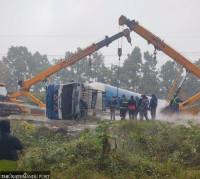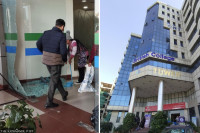National
NEA and agitating locals of Lapsiphedi reach agreement to normalise the situation
Locals protested against the planned substation arguing that it would displace the settlement there
Prithvi Man Shrestha
Nepal Electricity Authority has reached a three-point agreement with agitating locals of Lapsiphedi area of Shankarapur Municipality-3, on the outskirts of Kathmandu, to ease the situation that turned tense following a dispute over a planned construction of substation for 400kV Naya Khimti-Barhabise-Lapsiphedi transmission line.
A group of locals have been protesting against the planned construction of a substation at the human settlement demanding relocation of the substation to another place. On the other hand, the state power utility body has been arguing that the substation cannot be relocated as it is in the last stage of construction of the transmission line. The authorities have insisted that the proposed location is the best suited for the substation.
With the protestors obstructing the work of the NEA, the future of the transmission line which the NEA considers vital for meeting growing power demands in the Kathmandu Valley, has become uncertain.
In view of the complex situation, the NEA on Friday invited a group of agitating locals to discuss the matter and they reached a three-point agreement to ease the situation after five-hour long negotiations.
In a press statement on Saturday morning, the NEA said that the locals have agreed to discontinue the ongoing obstruction while the local administration would withdraw the police mobilised there.
Likewise, the power utility body will suspend drilling and survey works being undertaken at the proposed location for the substation for five days. “But the NEA will be allowed to carry out its works from the sixth day and there will be no obstruction on the works,” the NEA said.
A coordination committee has been formed headed by ward-7 chairperson Bishnu Prasad Shrestha to discuss with the locals on the positive and negative impact of the transmission line projects, and the demands of the locals. Krishna Chandra Poudel, under secretary at the Area Administration Office, Sankhu; Surya Bahadur Tamang, ward-3 chairperson; Ranjit Tamang, president of Tamang Sarokar Samaj; and locals Phurba Lama and Pawan Waiba are members of the committee. The committee will submit its report within five days after interacting with the locals, according to NEA.
Ward-3 Chairperson Tamang, who is accused of instigating the locals, said that no agreement has been reached regarding how to settle the issue. “The agreement was reached to calm down the situation immediately,” he told the Post.
Earlier, various non-government organisations also expressed their solidarity with the locals. For example, some fringe political parties such as the Struggle Against Marginalisation of Nationalities and Nepal Tamang Dhedun protested against substation plans, reminding them that evicting the indigenous nationalities and local people from their locality would be against international conventions that Nepal is a party with.
Ongoing local obstruction to building power substations is the latest example of the difficulty the power utility has faced to construct transmission lines in the country after facing similar problems in many other projects in the past.
According to the NEA, it is a very important project that delivers power from the hydropower projects built in the Tamakoshi and Sunkoshi rivers and their tributary streams to the Kathmandu Valley, which is the country’s largest consumption centre of energy.
For example, the 456MW Upper Tamakoshi Hydropower Limited, Nepal’s largest operating hydropower project currently, came into commercial operation in August 2021. But the NEA has not been able to supply its power to Kathmandu Valley due to delays in completing this transmission line project.
Now, with disputes with the locals at the site of the proposed substation at Lapsiphedi, it will take more time for NEA to deliver power from Upper Tamakoshi to Kathmandu Valley.
The villagers have been preventing construction at the project site for the past two years in order to prevent the construction of the substation near a Tamang settlement, according to the state-owned power utility.
There had not been any local demonstrations when the power utility initially granted a contract to a Chinese joint venture company in December 2017. The project is experiencing obstruction, according to the NEA, when the new Indian contractor—Larsen & Toubro Limited- was hired in November 2020—after the contract with the former one was cancelled owing to slow work progress.
“Rather than those whose lands were acquired, some locals around the area have been obstructing the substation construction by bringing local women forward,” the NEA said in its earlier statement.
Due to obstruction, the NEA extended the contract of substation to Indian contactor— till December-end 2023 since the locals won't let the Indian contractor, Larsen & Toubro Limited, work on the project.
The NEA claims that individuals other than those whose lands were acquired have organised the protest. The power utility body said that it has already compensated 49 out of 50 landowners for acquiring the land in early 2018.
The power utility claims that the dispute was artificially created to politicise the issue and win the elections. In fact, Shankarapur Municipality itself in its budget and programme unveiled for the current fiscal year (2022-23) has vowed to make efforts to transfer the proposed substation to another location.
“As the substation and the Tamakoshi Transmission line will affect the settlement of indigenous nationalities, a request will be made to take ahead the process of transferring the substation to other locations,” the budget and programme 2022-23 of the local government states.
However, NEA is fearful that obstruction in Lapsiphedi could set bad precedents to build other nearly two dozens of substations around the Kathmandu Valley.
Projecting that there will be a demand for 3000MW of electricity in the Valley by 2050, the NEA has been expanding the 220kV transmission line around the Valley. “For this, 20 new substations need to be built inside the Valley,” the NEA said in its earlier statement. “If such obstruction continues, how can we build other substations?”
NEA Managing Director Kul Man Ghising has been publicly warning that Kathmandu Valley could see the return of load shedding if the proposed substation at Lapsiphedi is not allowed to be constructed.




 8.12°C Kathmandu
8.12°C Kathmandu













%20(1).jpg&w=300&height=200)

